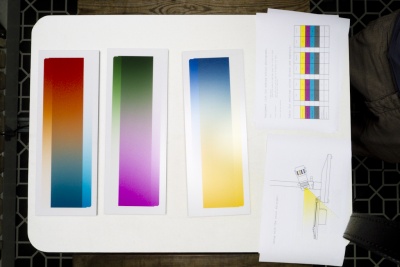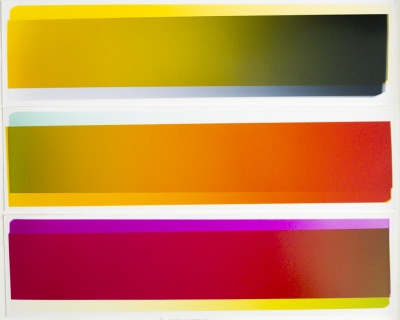Lucian Wester, Trimester 3, 2012
Lucian Wester Colour tests, Trimester 3, 2012.
Description
I will be working with a color system in the colordarkroom to create new works. And I want to try to document the process of making the works and the system involved to create a kind of code for making real Lucian Westers. This is of course something that is meant to be ironic.
The works will be three test strokes with six colour gradients pared: yellow/bleu, cyan/red and magenta/green (see image below). Placing the colour photo paper ad an angle to the light source makes these gradients. These works will be accompanied by all the data that was required to make them, such as: all the colour filter information and maybe more test that I made to create these works. With these works I want to explore the possibilities of light in abstract way, but ad the same time I’m exploring the possibilities and impossibilities of the standard mechanically produced photo paper.
Media
Photos
Final works
Some tests
Essay
Two reviews of exhibitions.
texts thematic
Michel Gondry
You’ll like this film because you’re in it: the be kind rewind protocol.
Gondry starts with telling us about his utopian idea of communities making their own movies. And what he in the end creates is indeed his utopian idea. Gondry states that he needed to make all the rules and sets in order to leave and create more space for the actual creative filmmaking. The participants otherwise didn’t know what to do or how to start. Through his protocol a group would collectively make a film whereas in Hollywood al the decisions are made by the director, Gondry explains (although I think that a producer has also al lot of influence, why otherwise al the director cuts on DVDs?). But isn’t Gondry, on a Meta level, not the director of all the movies created within the gallery space? Through his protocol there is not much space for experiment or different forms of filmmaking other than the by Gondry dictated Hollywood’s way with sets and genres. The whole project eventually has not so much to do with creativity but rather more with giving a work process for a community to make a film. It is the community who needs the rules not the creativity.
Propp, Morphology of the Folktale
The text shows us by examining 100 folktales that there is a strict structure that makes up these stories. In the preface the author suggest that the fact that this is possible that maybe the same or similar structures can be applied to other forms of story telling or the code can be used to generate new folktales. For example almost every story has to have a main character trough which the audience will experience the story. Of course there are different modes of story telling but there’s in every case a main character even when its only for a short period in the story. But what I think is more interesting to turn it around and think about the structure or code. Because doesn’t a code always implies a certain narrative? For example a code/structure within a factory that describes the process of making products is a narrative. At the beginning of the factory line you start with raw material and at the end of the line you end up with a finished product, a linear story. The question that remains is: if there are codes that don’t create narratives? And if there are narratives that are not build from codes?
Richard Florida
The Rise of the Creative Class Richard describes in essence a new class which has become a large part of economic and capital value: the Creative Class. There are some interesting paradoxes surrounding the Creative Class most of all the fact that Richard successfully characterises them, while one of their main characters is that they want to be individual and independent. The Creative Class needs other Classes to rebel against; it’s one of its main characters. Richard says that there is only growth through getting the Creative Class into your city, but what is there to say fore the old people. Within the upcoming years there is going to be a lot old people with money. What is interesting is that Florida truthfully believes that all the people in the creative class make a lot of money, of course the creative class is much bigger than the creative industry but still there’s also a lot of precarious work and people having second jobs to pay fore their bills. So if Florida’s creative class is defined by their economic and capital value we might exclude the avangarde of the this class: the artist.
Chuck Kleinhans
Creative Industries
Chuck describes how and why Richard Florida idea about the creative class/industry was a bit to optimistic, for example the increase of precarious work and the speedup. He says about capitalism that it is all ‘about expanding and maximizing capital itself.’ He also describes that all workers want to get a better job if they can to earn more money except fore artist, they will take low paid jobs because they find satisfaction in their artistic work. I do think that this also count fore a lot more people than artist; if people enjoy work their work and they like their colleagues they wont take a job that is less pleasant but its better paid. Real capitalisms don’t exist. If we lived in such a system there would not be things like for example free marriage (from a capitalists view point: a largely capital alliance between two people) but forced marriages to expand and maximize capital like in the old days. And of course there are many more examples but what’s more interesting to see is that capitalism maybe the dominating structure it isn’t the only thing.
A few days ago I saw in a TV programme that more and more manufacturing companies don’t start factories any more in China but prefer their homeland because it becoming cheaper. This is dew to the fact that people in China getting better paid but the quality of the products isn’t getting any better. This programme was mostly about small companies but also bigger multinationals are making steps to relocate their factories back to their homelands. If the wealth around the world is more equally spread there will be no need to build a factory on the other side of the world.
CLICK
CLICK stands for Creativity, Learning, Innovation, Co-creation and Knowledge. It is basically a small agency that has the function to bring different field of the creative industry together to make the whole creative industry. The Dutch government thinks that by letting different flied work together both will make more profits, which must lead to that the Netherlands will have the biggest Creative industry in Europe by 2020. This agency (CLICK//NL) will get the money to start up from the private sector, knowledge institutions, government, research centres, ect. CLICK//Network consist of all the different fields within the creative industry such as the gaming industry, fashion, media and ICT, design, architecture and cultural heritage. Essentially working together will generate a lot of money.
One thing that is not mentioned in the text are the fine, or autonomous arts they do not exist in this system anymore or they are of no value to it? To comment on that I would like to very loosely quote Jan Dibbets; People like Jan de Bouvrier (a Dutch designer) would not have existed if Piet Mondriaan and De Stijl had not have been there before him, even IKEA would not have existed. I agree with Dibbets and I think that it is impossible to integrate the autonomous arts into an instant money making system because sometimes it takes time make it into something profitable. And sometimes it’s simply not profitable at all and that’s great!
thematic project text
I will be working with a color system in the colordarkroom to create new works. And I want to try to document the process of making the works and the system involved to create a kind of code for making real Lucian Westers. This is of course something that is meant to be ironic.
The works will be three test strokes with six colour gradients pared: yellow/bleu, cyan/red and magenta/green (see image below). Placing the colour photo paper ad an angle to the light source makes these gradients. These works will be accompanied by all the data that was required to make them, such as: all the colour filter information and maybe more test that I made to create these works. With these works I want to explore the possibilities of light in abstract way, but ad the same time I’m exploring the possibilities and impossibilities of the standard mechanically produced photo paper.
Additional Information
optional
- Project URL (if lives on an external site)
- extra wiki links (in case you have relevant notes/journals/documentation in your User: page, this is useful particularly if you have been asked to articulate further or refine your project during your assessment)
- Animated GIFs


